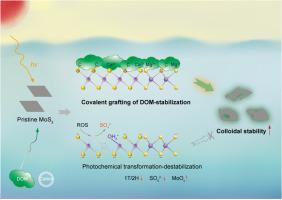当前位置:
X-MOL 学术
›
Water Res.
›
论文详情
Our official English website, www.x-mol.net, welcomes your feedback! (Note: you will need to create a separate account there.)
The colloidal stability of molybdenum disulfide nanosheets in different natural surface waters: Combined effects of water chemistry and light irradiation
Water Research ( IF 11.4 ) Pub Date : 2024-06-19 , DOI: 10.1016/j.watres.2024.121973 Kexin Chen , Xiaoyun Xu , Xing Li , Xiangyang Gui , Ling Zhao , Hao Qiu , Xinde Cao
Water Research ( IF 11.4 ) Pub Date : 2024-06-19 , DOI: 10.1016/j.watres.2024.121973 Kexin Chen , Xiaoyun Xu , Xing Li , Xiangyang Gui , Ling Zhao , Hao Qiu , Xinde Cao

|
With the increasing production and application, more molybdenum disulfide (MoS) nanosheets could be released into environment. The aggregation and dispersion of MoS nanosheets profoundly impact their transport and transformation in the aquatic environment. However, the colloidal stability of MoS remains largely unknown in natural surface waters. This study investigated the colloidal stability of MoS nanosheets in six natural surface waters affected by both light irradiation and water chemistry. Compared to that of the pristine MoS nanosheets, the colloidal stability of MoS photoaged in ultrapure water declined. Light irradiation induced the formation of Mo-O bonds, the release of SO species, and the decrease in 1T/2H ratio which reduced negative charge and enhanced hydrophobicity. However, the colloidal stability of MoS photoaged in natural surface waters was increased relative to that in ultrapure water not only for the smaller extent of photochemical transformation but more importantly the surface modification by water chemistry. Furthermore, the colloidal stability of MoS photoaged in natural surface waters followed the order of sea water > lake water > river water. The abundant cations (e.g., Ca and Mg) in sea water facilitated the covalent grafting (S-C bonds) of more dissolved organic matter (DOM) on MoS via charge screening and cation bridging, thus inducing stronger electrostatic repulsion and steric effect to stabilize nanosheets. The crucial role of the covalent grafting of DOM was further confirmed by the positive correlation between the critical coagulation concentration values and S-C ratios (R = 0.82, < 0.05). Our results highlighted the dominant role of water chemistry than light irradiation in dictating the colloidal stability of MoS photoaged in natural surface waters, which provided new insight into the environmental behavior of MoS in aquatic environment.
中文翻译:

二硫化钼纳米片在不同天然地表水中的胶体稳定性:水化学和光照射的综合影响
随着生产和应用的不断增加,更多的二硫化钼(MoS)纳米片可能被释放到环境中。 MoS2纳米片的聚集和分散对其在水生环境中的运输和转化产生了深远的影响。然而,MoS2 在天然地表水中的胶体稳定性仍然很大程度上未知。本研究研究了二硫化钼纳米片在六种天然地表水中受光照射和水化学影响的胶体稳定性。与原始MoS2纳米片相比,MoS2在超纯水中的光老化胶体稳定性下降。光照射诱导Mo-O键的形成、SO物质的释放以及1T/2H比率的降低,从而减少负电荷并增强疏水性。然而,天然地表水中的MoS2光老化的胶体稳定性相对于超纯水中的胶体稳定性有所提高,这不仅是因为光化学转化程度较小,更重要的是通过水化学进行了表面改性。此外,自然地表水中MoS光老化的胶体稳定性遵循海水>湖水>河水的顺序。海水中丰富的阳离子(例如Ca和Mg)通过电荷屏蔽和阳离子桥联促进更多溶解的有机物(DOM)在MoS上的共价接枝(S-C键),从而诱导更强的静电排斥和空间效应来稳定纳米片。临界混凝浓度值与S-C比率之间的正相关性(R = 0.82,< 0.05)进一步证实了DOM共价接枝的关键作用。 我们的结果强调了水化学比光照射在决定天然地表水中MoS2光老化的胶体稳定性方面的主导作用,这为水生环境中MoS2的环境行为提供了新的见解。
更新日期:2024-06-19
中文翻译:

二硫化钼纳米片在不同天然地表水中的胶体稳定性:水化学和光照射的综合影响
随着生产和应用的不断增加,更多的二硫化钼(MoS)纳米片可能被释放到环境中。 MoS2纳米片的聚集和分散对其在水生环境中的运输和转化产生了深远的影响。然而,MoS2 在天然地表水中的胶体稳定性仍然很大程度上未知。本研究研究了二硫化钼纳米片在六种天然地表水中受光照射和水化学影响的胶体稳定性。与原始MoS2纳米片相比,MoS2在超纯水中的光老化胶体稳定性下降。光照射诱导Mo-O键的形成、SO物质的释放以及1T/2H比率的降低,从而减少负电荷并增强疏水性。然而,天然地表水中的MoS2光老化的胶体稳定性相对于超纯水中的胶体稳定性有所提高,这不仅是因为光化学转化程度较小,更重要的是通过水化学进行了表面改性。此外,自然地表水中MoS光老化的胶体稳定性遵循海水>湖水>河水的顺序。海水中丰富的阳离子(例如Ca和Mg)通过电荷屏蔽和阳离子桥联促进更多溶解的有机物(DOM)在MoS上的共价接枝(S-C键),从而诱导更强的静电排斥和空间效应来稳定纳米片。临界混凝浓度值与S-C比率之间的正相关性(R = 0.82,< 0.05)进一步证实了DOM共价接枝的关键作用。 我们的结果强调了水化学比光照射在决定天然地表水中MoS2光老化的胶体稳定性方面的主导作用,这为水生环境中MoS2的环境行为提供了新的见解。











































 京公网安备 11010802027423号
京公网安备 11010802027423号